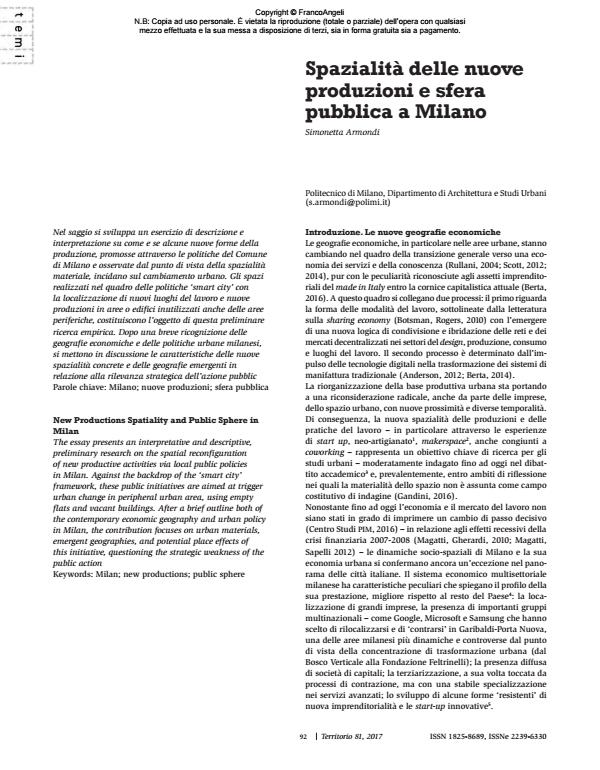New Productions Spatiality and Public Sphere in Milan
Journal title TERRITORIO
Author/s Simonetta Armondi
Publishing Year 2017 Issue 2017/81 Language Italian
Pages 5 P. 92-96 File size 1324 KB
DOI 10.3280/TR2017-081021
DOI is like a bar code for intellectual property: to have more infomation
click here
Below, you can see the article first page
If you want to buy this article in PDF format, you can do it, following the instructions to buy download credits

FrancoAngeli is member of Publishers International Linking Association, Inc (PILA), a not-for-profit association which run the CrossRef service enabling links to and from online scholarly content.
The essay presents an interpretative and descriptive, preliminary research on the spatial reconfiguration of new productive activities via local public policies in Milan. Against the backdrop of the ‘smart city’ framework, these public initiatives are aimed at trigger urban change in peripheral urban area, using empty flats and vacant buildings. After a brief outline both of the contemporary economic geography and urban policy in Milan, the contribution focuses on urban materials, emergent geographies, and potential place effects of this initiative, questioning the strategic weakness of the public action
Keywords: Milan; new productions; public sphere
- Anderson C., 2012, Makers. The New Industrial Revolution. New York: Crown.
- Andreotti A., 2006, «Milan: Urban Poverty in a Wealthy City». In: Musterd S., Murie A., Kesteloot C. (eds.), Neighbourhoods of Poverty: Urban Social Exclusion and Integration in Comparison Europe. London: Palgrave Macmillan.
- Armondi S., 2015, «Spazio urbano, nuove geografie della produzione. Una lettura internazionale». Imprese & Città, 8: 56-63.
- Armondi S., 2012, «Quale urbanistica dopo la crescita? Riflessioni sul nesso dismissione/riuso». Urbanistica, 149: 120-128.
- Assolombarda, 2015, Il lavoro a Milano, Milano: Centro Studi Assolombarda.
- Berta G., 2016, Che fine ha fatto il capitalismo italiano?. Bologna: il Mulino.
- Berta G., 2014, Produzione intelligente, un viaggio nelle nuove fabbriche. Torino: Einaudi.
- Bolocan Goldstein M., 2016, «Rapporti territoriali nella grande contrazione. Osservazioni sulla regione metropolitana Milanese». In: Milano produttiva, 26° Rapporto della Camera di Commercio di Milano.
- Botsman R., Rogers R., 2010, What’s Mine Is Yours: The Rise of Collaborative Consumption. usa: Harper Collins.
- Brenner N., Schmid C., 2015, «Towards a New Epistemology of the Urban?». City, 2-3: 151-182. DOI: 10.1080/13604813.2015.1014712
- Bruzzese A., 2015, «Does Space Matter? intorno agli spazi dell’innovazione». Imprese & Città, 8: 63-72.
- Camera di Commercio Milano, 2016, Milano produttiva, 26° Rapporto della Camera di Commercio di Milano.
- Centro Studi pim, 2016, «Spazialità metropolitane. Economia, società e territorio». In: Argomenti e Contributi, 15: monografico.
- Cognetti F., 2014, a cura di, Vuoti a rendere. Milano: Fondazione Politecnico di Milano.
- Comune di Milano, Fondazione Brodolini, 2016, Libro bianco sull’innovazione sociale. Rapporto non pubblicato.
- Cucca R., Ranci C., 2017, a cura di, Unequal Cities. The Challenge of Post-Industrial Transition in Times of Austerity, London: Routledge.
- Di Vita S., Morandi C., 2015, «itc, nuove modalità di produzione e processi di rigenerazione urbana. I fablab a Milano». Imprese & Città, 8: 81-89.
- Evans G., 2009, «Creative Cities, Creative Spaces and Urban Policy». Urban Studies, 5: 1003-1040.
- Gandini A., 2016, The Reputation Economy: Understanding Knowledge Work in Digital Society. London: Palgrave Macmillan.
- Gascó M., Trivellato B., Cavenago D., 2015, «How Do Southern European Cities Foster Innovation? Lessons from the Experience of the Smart City Approaches of Barcelona and Milan». In: Gill Garcia J.R., Pardo T.A., Nam T. (eds.), Smarter as the New Urban Agenda: A Comprehensive View of the 21st Century City. Switzerland: Springer.
- González S., 2009, «(Dis)connecting Milan(ese): Deterritorialised Urbanism and Disempowering Politics in Globalising Cities». Environment and Planning A, 4: 31-47.
- Hollands R.G., 2008, «Will the Real Smart City Please Stand Up?». City: Analysis of Urban Trends, Culture, Theory, Policy, Action, 3: 303-320. DOI: 10.1080/13604810802479126
- Indergaard M., Pratt A.C., Hutton T.A., 2013, eds., «Creatives Cities after the Fall of Finance». In: Cities, 33: 1-96 (special issue).
- Jessop B., Brenner N., Jones M., 2008, «Theorizing Sociospatial Relations». Environment and Planning D, 3: 389-401.
- Lanzani A., Merlini C., Zanfi F., 2014, «Quando ‘un nuovo ciclo di vita’ non si dà. Fenomenologia dello spazio abbandonato e prospettive per il progetto urbanistico oltre il paradigma del riuso». Archivio di Studi Urbani e Regionali, 109: 28-47.
- Lanzani A., 2105, Città territorio urbanistica tra crisi e contrazione. Milano: FrancoAngeli.
- Magatti M., Gherardi L., 2010, a cura di, The City of Flows. Territories, Agencies and Institutions. Milano: Bruno Mondadori.
- Magatti M., 2012, La città abbandonata. Dove sono e come cambiano le periferie italiane. Bologna: il Mulino.
- Magatti M., Sapelli G., 2012, a cura di, Progetto Milano. Milano: Mondadori.
- Mariotti I., Di Vita S., Limonta G., 2015, «Una geografia degli spazi di coworking a Milano». Imprese & Città, 8: 72-81.
- Mazzoleni C., 2016, «Knowledge-Creating Activities in Contemporary Metropolitan Areas, Spatial Rationales and Urban Policies: Evidence from the Case Study of Milan». In: Cusinato A., Philippopoulos-Mihalopoulos A., (eds.), Knowledge-creating Milieus in Europe. Berlin: Springer.
- Menichinelli M., 2016, Fab lab e maker. Macerata: Quodlibet.
- Micelli S., 2016, Fare è innovare. Bologna: il Mulino.
- Pacchi C., 2015, «Coworking e innovazione urbana a Milano». Imprese & Città, 8: 89-96.
- Pasqui G., 2015, «Segnali di futuro? Spazi e pratiche del lavoro e della produzione a Milano». Imprese & Città, 8: 51-56.
- Rabari C., Storper M., 2014, «The Digital Skin of Cities: Urban Theory and Research in the Age of the Sensored and Metered City, Ubiquitous Computing and Big Data». Cambridge Journal of Regions Economy and Society, 1: 27-42.
- Scott A.J., 2012, A World in Emergence. Cities and Regions in the 21st Century. Northampton: Edward Elgar.
- Scott A.J., 2014, «Beyond the Creative City: Cognitive-cultural Capitalism and the New Urbanism». Regional Studies, 4: 565-578. DOI: 10.1080/00343404.2014.891010
Simonetta Armondi, Spazialità delle nuove produzioni e sfera pubblica a Milano in "TERRITORIO" 81/2017, pp 92-96, DOI: 10.3280/TR2017-081021